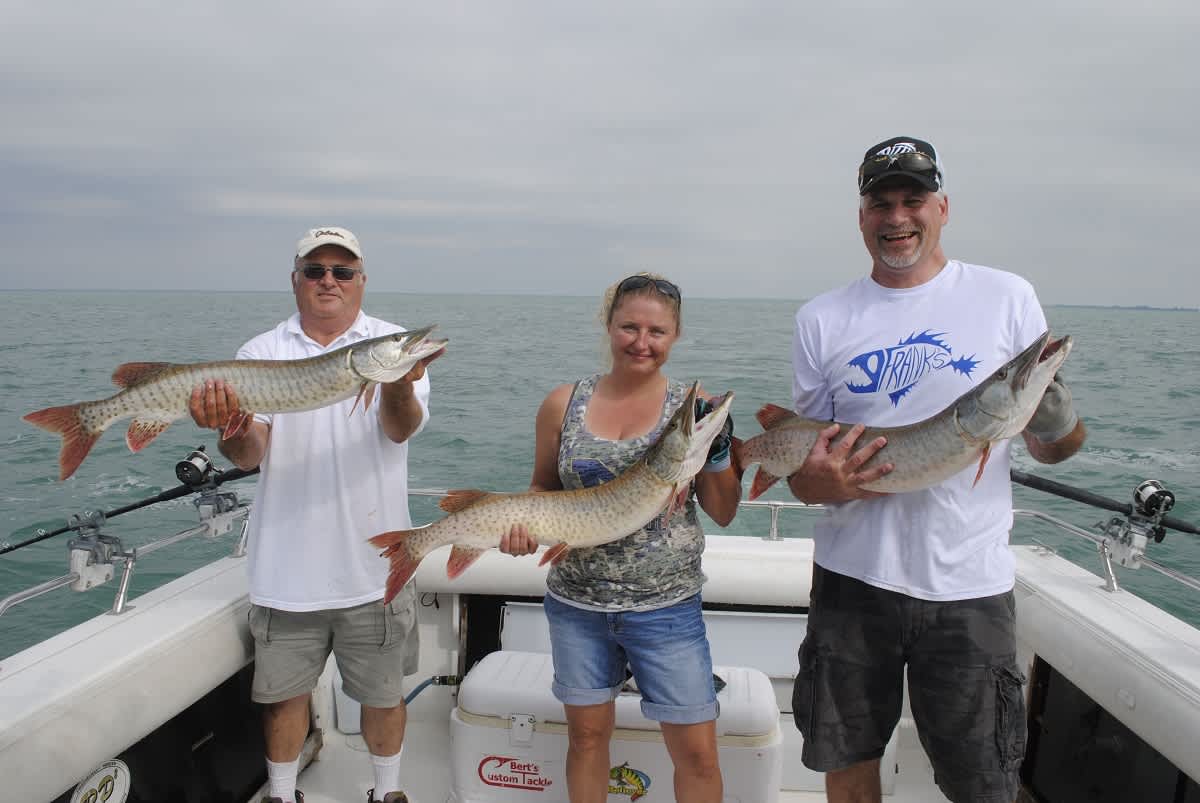Lake St. Clair: Not Just for Bass Fishing
Bob Gwizdz 09.22.15

It’s no secret that Lake St. Clair is among the best bass fisheries in North America. But did you know that it’s an outstanding muskellunge fishery as well? Its muskie population is substantial. And a lot of them are big.
It wasn’t always that way. Muskies, which are pretty hard to come by most places, are so common these days that what used to be a considered good day—catching one—is almost taken for granted now.
“Only on Lake St Clair do you apologize when you send people home after catching three or four muskies because it was slow,” said Don Miller, a long-time charter boat skipper on the big lake.
I hitched a ride aboard Miller’s 30-foot Baha Cruiser the other day when he had a couple of his regular customers fishing with him. We started setting lines around 10 a.m., and within an hour, we had our first hook up. It didn’t last long; the fish was on for a minute or so and Becky Dean, who was handling the rod, hadn’t even begun gaining line before it pulled free.
It was more than an hour before the anglers had another chance at a muskie—they were interrupted by a 33-inch pike—when a big fish hit.
The fish took a Lapper Lure (a jointed plug, made in Michigan) that Miller trolled at four miles an hour in 19 feet of water off of planer board. The fish went crazy; Miller turned the boat to keep it from tangling in other lines before we could get them cleared, but even then it was in danger of hanging up on the planer board before Mark Olschanski muscled it away and brought it in.
Miller guessed it at 50 inches and around 30 pounds. Miller’s mate Denny Wilton unhooked the fish and slid it into the livewell, which is something Miller started doing six or seven years ago.
“Most of the bigger boats have livewells now,” said Miller, 61, who’s been running a charter boat for 33 years. “It gives the fish a chance to calm down and recover its equilibrium before you let it go. I usually keep them for 10 or 15 minutes, until they start feeling better, before you put them back into the lake.”
The weather—intermittently overcast with a big chop on the surface—was prefect for “a big-fish day,” Miller said.
“When you’ve got a good chop like this, they come up in the water column,” Miller explained. “Your hottest fish are always up high. I always run at least one bait up near the surface. The old-timers say you’re not musky fishing if you’re not fishing high.”
Having started out on a high note—“Any day you catch a 50-inch muskie is a good day,” Miller said—the captain decided to fish the same area, hoping there were more big ones in the vicinity. It didn’t turn out that way. We went more than an hour with a strike when the next fish hit a large double-spinner bucktail (a color the guys call “strawberry shortcake”—pink with gold blades). It was in the 35-inch range, but looked like a baby compared to the first one.
Ten minutes later, we caught another, maybe a tad smaller, on a rattlesnake-colored Lapper.
“Lappers have been the best bait on my boat this year,” Miller said. “It’s been lights out—it’s probably accounted for 100 muskies.”
Miller said he typically catches 300 to 400 muskies a year these days.

“When I first started out, if I saw 60 a year I was doing well,” he said. “A hundred was the goal and we never seemed to make it. Now, with the catch-and-release ethic and the livewells, there are a lot more muskies to be caught in Lake St. Clair.”
About the time we were ready to take the two ‘skis out of the livewell and let them go, another rod went off, this one on a Wylie. Dean fought it right to the transom and Wilton had the landing net in the water the fish made a frantic charge, got under the swim platform, and was able to get enough slack in the line to throw the bait.
But no sooner had we got the line back in the water when another muskie, in the same size class, hit. That’s four bites in 45 minutes and we boated three of them.
Miller was a little disappointed by their size, though.
“People come to St. Clair because they know they have a chance to catch a big fish now,” Miller said. “I couldn’t count the number of states people have come from to fish for muskies with me and they’ve come from probably 15 different countries. I get Europeans—often from England or Germany—every year.
“About one in every eight or nine fish is a 48-incher or better,” he continued. “I’ve had a lot of fish in the 50-inch class this year. When you start getting into 52- to 54-inch fish, they’ll weight around 40 pounds. There have been a lot of 38- to 40-pound fish around, but a 38-pound fish a 40-pounder that hasn’t eaten its dinner yet. It eats one smallmouth bass and it’s up over 40.”
We wouldn’t see another fish. The sun came out, the wind settled and the bite died. But we’d gone four for six with a 50-incher (and a bonus pike). That’s good muskie fishing.
Visit www.millers-sportfishing.com for more information on Miller’s charter operations.
For more information on Michigan fishing go to michigan.org. Click here to purchase a Michigan fishing license online.
This article was produced in partnership with Pure Michigan.

